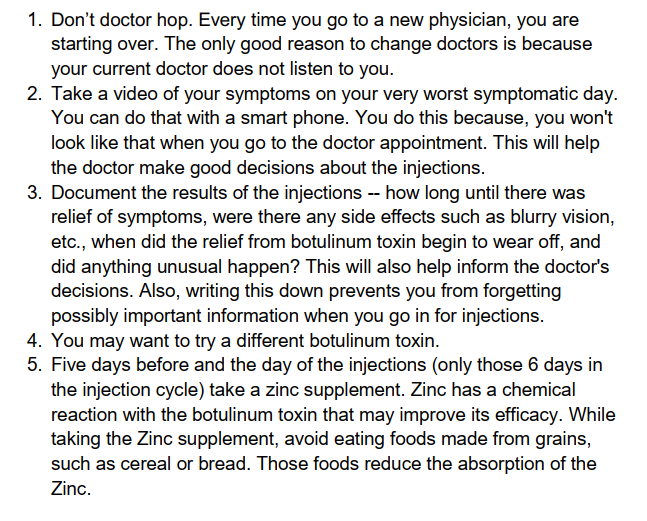Injection Tips
It is very important to have realistic expectations for the injections.
Everyone’s face is different, and everyone’s blepharospasm symptoms will be different. Consequently, it may take an injecting physician several tries to get the injection pattern, amount, and technique just right.
Here are some things that you can do to improve your chances for successful injections:

Injection Journal
How to fill out your journal
- Have your doctor fill out your facial map with the dosage and placement of each injection.
- Make sure your facial map is dated in case you need to refer to it later.
- On your calendar (for each month) mark the scale of 1 – 10 for:
- The severity of spasms, Dry Eye, and Photosensitivity
- Mark the day your toxin starts working.
- Mark when your toxin is at its peak.
- Mark when your toxin starts to wear off.
- Mark when your toxin fully wears off.
- Star stressful days for you, and the event that caused it.
- Keep track of good days.
- Have pages after each calendar month to journal and jot down extra things you need to keep track of.
- Make note of any side effects you have from your injections and how long they last.
- Write down anything abnormal with your eyes to tell your doctor.
- Make note if you stumble or fall due to your eyes.
Common injection patterns and techniques
Keep in mind that there is no one right way to inject for Blepharospasm. Each individual is different, and therefore will need to work closely with their doctor to find what works for them on sites and dosages.
However, here are some of the common injection sites and a technique performed by Dr. Jinnah on pretarsal

How to get your injections more frequently
Our Board Member, Jane, has put together some things to help patients get their injections more frequently. Here is what she has to say, and the material she has put together.
Hello all,
I’ve put together a few things that patients and/or physicians can use in appealing to insurance companies to allow injections more frequently than every 12 weeks. This is near and dear to my heart because my first injector was dogmatic that my injections should last 12 weeks and he made me feel crazy when I told him they didn’t (I get injected every 10 weeks now with a different physician). In my case, it wasn’t an insurance issue….just ignorance and a lack of humility on the part of my physician.
Many insurers follow protocols which can be overruled if patients and/or doctors take the time to appeal. When I was practicing, I spent a lot of time each week speaking to the medical directors of various insurance companies (in my case, mostly Medical HMO’s) to get things approved (drugs, procedures, visits to specialists, etc.) that were not covered on their protocols/algorithms. I found all of the medical directors very receptive to my appeals, especially, when they were given data that supported my position. If someone’s physician is unwilling to spend the time to make an appeal, insurance companies have phone numbers and procedures in place for patients to register their own complaints/appeals. I’m not as familiar with Medicare, and certainly, if we can get this done on a policy level through our advocacy, that would save a lot of work for individuals.
Attached documents include:
1) an article from our newsletter July/Aug/Sept 2015 Volume 34 Number 3
2) an abstract from the journal Neurology 1987 Volume 37:616-623 by Dr. Jankovic and Janet Orman which notes that the duration of beneficial effects from botulinum toxin in blepharospasm and oromandibular-cervical dystonia ranges from 5 to 28 weeks with a mean of 12.5 weeks.
3) Results from our 2019 BEBRF survey of 285 blepharospasm patients
4) an article from Dr. Richard Anderson et.al. Ophthalmic Plastic and Reconstructive Surgery 1998 Volume 14, #5, pages 305-317(page 312 contains information about botulinum toxin duration)
Hope that can help someone in the appeals process.
Jane
Weeks of botulinum toxin efficacy, BEBRF survey 2019
BEBRF Newsletter Fall 2020 Vol 40 Issue 4
Blepharospasm – Past Present Future – Anderson et al 1998
Fezza et al – 2016 from Allergan
injection frequency – BEBRF 3Q2015 newsletter (Burns MD)
Jankovic & Orman – 1987 botulinum toxin study (Neurology – abstract)
Safety of Pretarsal Botulinum Toxin for Blepharospasm Associated Pseudo
Watch Video
How to Get the Most Out of Your Injections
August 26, 2022
Charlene Hudgins, Executive Director & Angel Roberts, Office Manager
The video is on Youtube so, if you can watch other videos on Youtube, you should be able to watch this video.
How to Get the Most Out of Your Injections with speakers Charlene Hudgins & Angel Roberts
